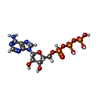+ Open data
Open data
- Basic information
Basic information
| Entry | Database: PDB / ID: 9ns5 | ||||||
|---|---|---|---|---|---|---|---|
| Title | Get3(D57N)-Get4/5 Complex (ATP-bound) | ||||||
 Components Components |
| ||||||
 Keywords Keywords | CHAPERONE / membrane protein targeting / ATPase / protein complex | ||||||
| Function / homology |  Function and homology information Function and homology informationcell morphogenesis involved in conjugation with cellular fusion / GET complex / TRC complex / pheromone-dependent signal transduction involved in conjugation with cellular fusion / tail-anchored membrane protein insertion into ER membrane / Hydrolases; Acting on acid anhydrides / protein insertion into ER membrane / post-translational protein targeting to endoplasmic reticulum membrane / response to arsenic-containing substance / retrograde vesicle-mediated transport, Golgi to endoplasmic reticulum ...cell morphogenesis involved in conjugation with cellular fusion / GET complex / TRC complex / pheromone-dependent signal transduction involved in conjugation with cellular fusion / tail-anchored membrane protein insertion into ER membrane / Hydrolases; Acting on acid anhydrides / protein insertion into ER membrane / post-translational protein targeting to endoplasmic reticulum membrane / response to arsenic-containing substance / retrograde vesicle-mediated transport, Golgi to endoplasmic reticulum / response to metal ion / vesicle-mediated transport / protein folding chaperone / guanyl-nucleotide exchange factor activity / cytoplasmic stress granule / unfolded protein binding / response to heat / cellular response to oxidative stress / protein-macromolecule adaptor activity / endoplasmic reticulum membrane / endoplasmic reticulum / Golgi apparatus / ATP hydrolysis activity / ATP binding / metal ion binding / identical protein binding / nucleus / cytoplasm / cytosol Similarity search - Function | ||||||
| Biological species |  | ||||||
| Method | ELECTRON MICROSCOPY / single particle reconstruction / cryo EM / Resolution: 3.19 Å | ||||||
 Authors Authors | Kim, K.H. / Granados-Villanueva, D. | ||||||
| Funding support |  United States, 1items United States, 1items
| ||||||
 Citation Citation |  Journal: J Biol Chem / Year: 2025 Journal: J Biol Chem / Year: 2025Title: Get4/5-mediated remodeling of Get3's substrate-binding chamber: Insights into tail-anchored protein targeting by the GET pathway. Authors: Diego Granados-Villanueva / Andrew Rossow / Kelly H Kim /  Abstract: The Guided Entry of Tail-Anchored Proteins (GET) pathway ensures accurate targeting of Tail-Anchored proteins (TAs)-a diverse class of membrane proteins-to the endoplasmic reticulum (ER) membrane. In ...The Guided Entry of Tail-Anchored Proteins (GET) pathway ensures accurate targeting of Tail-Anchored proteins (TAs)-a diverse class of membrane proteins-to the endoplasmic reticulum (ER) membrane. In yeast, newly synthesized TAs are captured by Sgt2 and transferred to Get3 for delivery to the ER, where they undergo subsequent membrane insertion. Efficient and protected handoff of hydrophobic TAs from Sgt2 to Get3 is facilitated by the Get4/5 complex, which is thought to act as a scaffold to position TA-bound Sgt2 and Get3 in proximity while trapping Get3 in an ATP-bound conformation necessary for TA binding. To define the molecular basis for this process, we determined the cryo-EM structure of the Saccharomyces cerevisiae Get3-Get4/5 complex at 3.2 Å resolution. Our structure shows that Get4/5 remodels Get3's TA-binding chamber by unfolding helices that form the lateral walls of the chamber. We termed this region the "lateral gate," as its helix-to-coil transition makes the TA-binding chamber more solvent accessible. Molecular dynamics simulations highlighted the flexibility of the lateral gate, indicating it is structurally dynamic and prone to conformational changes. Mutagenesis studies showed that the lateral gate residues influence both the binding affinity of Get3 for Get4/5 and its ATPase activity. Additionally, our cryo-EM map shows that the Sgt2-binding domain of Get5 is positioned near the lateral gate opening of Get3's TA-binding chamber. Based on these findings, we propose a model in which Get4/5 opens Get3's TA-binding chamber to form a lateral opening, enabling protected, lateral transfer of TAs from Sgt2 to Get3. | ||||||
| History |
|
- Structure visualization
Structure visualization
| Structure viewer | Molecule:  Molmil Molmil Jmol/JSmol Jmol/JSmol |
|---|
- Downloads & links
Downloads & links
- Download
Download
| PDBx/mmCIF format |  9ns5.cif.gz 9ns5.cif.gz | 284.1 KB | Display |  PDBx/mmCIF format PDBx/mmCIF format |
|---|---|---|---|---|
| PDB format |  pdb9ns5.ent.gz pdb9ns5.ent.gz | 223.2 KB | Display |  PDB format PDB format |
| PDBx/mmJSON format |  9ns5.json.gz 9ns5.json.gz | Tree view |  PDBx/mmJSON format PDBx/mmJSON format | |
| Others |  Other downloads Other downloads |
-Validation report
| Summary document |  9ns5_validation.pdf.gz 9ns5_validation.pdf.gz | 1.2 MB | Display |  wwPDB validaton report wwPDB validaton report |
|---|---|---|---|---|
| Full document |  9ns5_full_validation.pdf.gz 9ns5_full_validation.pdf.gz | 1.3 MB | Display | |
| Data in XML |  9ns5_validation.xml.gz 9ns5_validation.xml.gz | 52.4 KB | Display | |
| Data in CIF |  9ns5_validation.cif.gz 9ns5_validation.cif.gz | 78.6 KB | Display | |
| Arichive directory |  https://data.pdbj.org/pub/pdb/validation_reports/ns/9ns5 https://data.pdbj.org/pub/pdb/validation_reports/ns/9ns5 ftp://data.pdbj.org/pub/pdb/validation_reports/ns/9ns5 ftp://data.pdbj.org/pub/pdb/validation_reports/ns/9ns5 | HTTPS FTP |
-Related structure data
| Related structure data |  49743MC M: map data used to model this data C: citing same article ( |
|---|---|
| Similar structure data | Similarity search - Function & homology  F&H Search F&H Search |
- Links
Links
- Assembly
Assembly
| Deposited unit | 
|
|---|---|
| 1 |
|
- Components
Components
-Protein , 3 types, 6 molecules CFADBE
| #1: Protein | Mass: 23768.344 Da / Num. of mol.: 2 Source method: isolated from a genetically manipulated source Source: (gene. exp.)   #2: Protein | Mass: 41936.328 Da / Num. of mol.: 2 / Mutation: D57N Source method: isolated from a genetically manipulated source Source: (gene. exp.)   References: UniProt: Q12154, Hydrolases; Acting on acid anhydrides #3: Protein | Mass: 38604.445 Da / Num. of mol.: 2 Source method: isolated from a genetically manipulated source Source: (gene. exp.)   |
|---|
-Non-polymers , 3 types, 5 molecules 




| #4: Chemical | ChemComp-ZN / | ||
|---|---|---|---|
| #5: Chemical | | #6: Chemical | |
-Details
| Has ligand of interest | Y |
|---|---|
| Has protein modification | N |
-Experimental details
-Experiment
| Experiment | Method: ELECTRON MICROSCOPY |
|---|---|
| EM experiment | Aggregation state: PARTICLE / 3D reconstruction method: single particle reconstruction |
- Sample preparation
Sample preparation
| Component | Name: Get3D(D57N)-Get4/5 Complex / Type: COMPLEX / Entity ID: #1-#3 / Source: RECOMBINANT |
|---|---|
| Molecular weight | Value: 0.21 MDa / Experimental value: YES |
| Source (natural) | Organism:  |
| Source (recombinant) | Organism:  |
| Buffer solution | pH: 7.5 |
| Specimen | Embedding applied: NO / Shadowing applied: NO / Staining applied: NO / Vitrification applied: YES |
| Vitrification | Cryogen name: ETHANE |
- Electron microscopy imaging
Electron microscopy imaging
| Experimental equipment |  Model: Titan Krios / Image courtesy: FEI Company |
|---|---|
| Microscopy | Model: TFS KRIOS |
| Electron gun | Electron source:  FIELD EMISSION GUN / Accelerating voltage: 300 kV / Illumination mode: FLOOD BEAM FIELD EMISSION GUN / Accelerating voltage: 300 kV / Illumination mode: FLOOD BEAM |
| Electron lens | Mode: BRIGHT FIELD / Nominal defocus max: 2800 nm / Nominal defocus min: 800 nm |
| Image recording | Electron dose: 40 e/Å2 / Film or detector model: GATAN K3 (6k x 4k) |
- Processing
Processing
| CTF correction | Type: PHASE FLIPPING AND AMPLITUDE CORRECTION |
|---|---|
| 3D reconstruction | Resolution: 3.19 Å / Resolution method: FSC 0.143 CUT-OFF / Num. of particles: 149868 / Symmetry type: POINT |
| Refinement | Highest resolution: 3.19 Å Stereochemistry target values: REAL-SPACE (WEIGHTED MAP SUM AT ATOM CENTERS) |
 Movie
Movie Controller
Controller



 PDBj
PDBj



